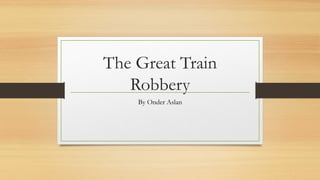The great train robbery
•Download as ODP, PDF•
0 likes•287 views
Vanessa coursework
Report
Share
Report
Share

More Related Content
What's hot (19)
Similar to The great train robbery
Similar to The great train robbery (20)
Film and video editing techniques template 2014 v2

Film and video editing techniques template 2014 v2
AARONHello All,After watching all the films in Week Two’s.docx

AARONHello All,After watching all the films in Week Two’s.docx
More from Ondera15
More from Ondera15 (20)
Recently uploaded
God is a creative God Gen 1:1. All that He created was “good”, could also be translated “beautiful”. God created man in His own image Gen 1:27. Maths helps us discover the beauty that God has created in His world and, in turn, create beautiful designs to serve and enrich the lives of others.
Explore beautiful and ugly buildings. Mathematics helps us create beautiful d...

Explore beautiful and ugly buildings. Mathematics helps us create beautiful d...christianmathematics
Recently uploaded (20)
Measures of Central Tendency: Mean, Median and Mode

Measures of Central Tendency: Mean, Median and Mode
ICT role in 21st century education and it's challenges.

ICT role in 21st century education and it's challenges.
Ecological Succession. ( ECOSYSTEM, B. Pharmacy, 1st Year, Sem-II, Environmen...

Ecological Succession. ( ECOSYSTEM, B. Pharmacy, 1st Year, Sem-II, Environmen...
Presentation by Andreas Schleicher Tackling the School Absenteeism Crisis 30 ...

Presentation by Andreas Schleicher Tackling the School Absenteeism Crisis 30 ...
Explore beautiful and ugly buildings. Mathematics helps us create beautiful d...

Explore beautiful and ugly buildings. Mathematics helps us create beautiful d...
Mixin Classes in Odoo 17 How to Extend Models Using Mixin Classes

Mixin Classes in Odoo 17 How to Extend Models Using Mixin Classes
On National Teacher Day, meet the 2024-25 Kenan Fellows

On National Teacher Day, meet the 2024-25 Kenan Fellows
General Principles of Intellectual Property: Concepts of Intellectual Proper...

General Principles of Intellectual Property: Concepts of Intellectual Proper...
The great train robbery
- 1. The Great Train Robbery By Onder Aslan
- 2. Introduction The Great Train Robbery was a western film that was first shown in the US on the 1st of December 1903(filmed in November that year). It is amongst the earliest existing films in America cinema, in fact it was first film that presented a narrative story which had a informative and organised structure as everything was in place. The plot of the movie was about a group of cowboy outlaws who hold up a train and rob the passengers and when are caught after are taken away by the sheriff. This film was directed by Edwin S. Porter who’s fabulous work which put this movie together got a lot of praise and credit. This movie is around 10 minutes and has a total of 14 scenes.
- 3. Continuity/workbench Editing • Continuity editing is a style of editing that requires the director to try to make the film reality as much like the audience's reality as possible. This means the film is trying to recreate what the world around us is and trying to make it easier on the audience to comprehend and understand the action happening on screen. Within this style of editing there are many terms or ways of implementing the style. These affects can be used independently of each other to create desired affects. • The Great Train Robbery not only was the first narrative film, it also introduced useful and efficient new (at the time) editing techniques which one of them was parallel editing. For example, rather than staying on one set, Porter took his crew to many different locations, including Edison's New York studio, Essex County Park in New Jersey, and along the Lackawanna railroad. • Furthermore, unlike other film attempts which kept a stable (hand held) camera position, Porter included a scene in which he panned the camera to follow the characters as they ran across a creek and into the trees to fetch their horses. • However, the most innovative editing technique introduced in The Great Train Robbery was the inclusion of crosscutting (when the film cuts between two different scenes that are happening at the same time). • Work bench cutting is where film is physically cut where the cut in the film should be and it is joined on with more film to create the cut to another shot. This technique was used before the invention of non-linear (Digital) editing. An example of work bench cutting being used was in 1903 Edwin Porters film “The Great Train Robbery”. Within 3 minutes 58 seconds into the film you can see the film cut from an interior room to an exterior location. I know that the workbench technique was used because it was a popular technique that was used extensively in early cinema. Another reason I know that workbench cutting was used and not editing in camera was because the indoor location would have been shot on a set and it would’ve been expensive to transport the same camera to an outdoor location rather than use a different one.